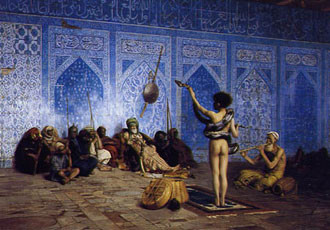Varisco, Daniel
Reading Orientalism: Said and the Unsaid
University of Washington Press
501 pages, 9 x 6 inches
ISBN 978 0295987521
Reading Orientalism is literally a re-reading of the late Edward Said’s Orientalism. Said’s powerful critique remains a milestone in the critical theory of academic bias three decades after its first publication. As the years go by, Orientalism survives more as an essential source to cite rather than a polemical text in need of thorough and open-minded reading. Read by academics as well as the general public in almost three dozen translations, Said’s text analyzes novels, travelogues and academic books to argue that a dominant imperialist discourse of West over East has underwritten virtually all past European and American representation of a so-called “Orient.” The debate over these views of Edward Said, a prominent intellectual of Palestinian heritage, continues unabated even after his passing in 2003.
Reading Orientalism presents an in-depth critical analysis of Said’s unrevised text. I examine Said’s rhetoric of persuasion as well as the credibility and accuracy of historical claims made in representing Orientalism as a unified Western discourse. The result is a critical study of the phenomenon of Orientalism and its profound impact on the intellectual and political culture of our times. Actually, Reading Orientalism is two books—one is a narrative couched in judicious satire of Said’s own writing style, and the other a comprehensive documentation buried in the endless set of endnotes.
The narrative argument engages the mind of the reader through a certain amount of playful, literary flirtation. As an intentioned author, my genealogy in re-approaching Edward Said prefers satirist Mark Twain to philologist Friedrich Nietzsche and extols the wit of Baron Montesquieu’s Persian Letters over Gustave Flaubert’s flirtation with an Egyptian dancer. Following a muse that can amuse at the same time that it disabuses the hubris of self-righteous posturing, I hark back to Oscar Wilde’s bon mot that those books which should not be read at all are “all argumentative books and all books that try to prove anything.” These are precisely the books we do need to read and understand why we do. Said’s Orientalism is such a book.

Following a muse that can amuse at the same time that it disabuses the hubris of self-righteous posturing, I hark back to Oscar Wilde’s <em id="">bon mot</em> that those books which should not be read at all are 'all argumentative books and all books that try to prove anything.' These are precisely the books we do need to read and understand why we do.
Said’s Orientalism, reviewed in over forty journals at the time of its publication, has left a wide range of criticism in its wake. Positioning himself as a literary David slinging barbs at the Goliath of academic dons and Middle East policy makers, Edward Said became almost impossible to separate from his text. He courageously brought attention to the bias and misrepresentation of Islam and Arabs in much previous Western writing. But in the process he made Orientalist discourse into as much an imaginary as the East/West binary clash he ridiculed.
I began writing this book just as the Twin Towers were destroyed by terrorists in 2001. There was at the time no overall critique of the faults in Orientalism, despite the extensive commentary the book had engendered across disciplines. Rather than debating the merits of Said’s thesis, most of the discussion revolved around personalities. Did you agree with Said that Western writers were biased by an Aeschylus-to-Kissinger discursive nature? Or with historian Bernard Lewis that all was well within the Ivory Tower? As I discovered the numerous errors in fact and rhetorical sleight of pen in Said’s text, I wondered how this book could have survived unrevised with such acclaim. What combination of factors led to the canonization of this single text as one of the most significant critical studies of the late twentieth century?
A major goal of my book is to unravel the mystique surrounding Said’s text, one that was cited almost everywhere, while its erudite prose was rarely read through cover to cover. There was so much passion surrounding Orientalism that I decided a more light-hearted approach was needed—if only for the sake of novelty. Reading Orientalism is a conscious parody of Said’s own book, in outline and style. The Introduction surveys the reception of Orientalism both by those who praised it and by those who panned it. The first chapter lays out the context of the text, with a brief tour down Orientalist memory land, a detailed criticism of Said’s definition of Orientalism as discourse, and a retelling of the early history of Oriental Studies from its Christian apologetic roots through to its academic establishment. The raw meat of the critique is hung out in anything but dry prose in chapter two, which provides a comprehensive review of the noted flaws in the text. These include Said’s emphasis on straw texts, such as Raphael Patai’s outdated The Arab Mind, historical errors, translation mistakes, blindness to gender in the texts he read, and anti-Marxist inattention to class and economics. Inspiring as readers found the text to be as a polemic, Orientalism lacked the rigor to be appreciated as sound intellectual history.
Perhaps the major problem with Said’s argument is the assumption that real Orientals could not represent themselves. By ignoring the rhetorical tit for colonialist tat of Arab and Muslim intellectuals, the real-world power of Orientalist discourse was overdrawn. Nor did Said look to critiques of bias within the tradition he calls Orientalism. He ignores such popular social satires as Montesquieu’s Persian Letters and Mark Twain’s Innocents Abroad. One of my main points is that Said’s textual attitude creates a novel argument out of blurred genres. The French intellectual Ernest Renan is privileged as a founding father of academic Orientalism, despite the fact that Renan’s texts had no continuing relevance and were criticized by other major scholars, including Ignaz Goldziher, who is conspicuously absent from Said’s book. Embarrassing misreadings of literary texts, including a poem by Goethe and a diary entry by Flaubert, further compromise Said’s argument. Even the novel Tancred by Benjamin Disraeli is forced into an Orientalist mode, ignoring the social satire and disapproval of anti-Semitism that permeate the Victorian text. Said reads Orientalist texts as though their contexts did not matter and he often reads only for damnable quotes.
The third and final chapter analyzes Said’s Orientalism thesis as an essentialism, a kind of Orientalism in perverse, by laying bare his application of Michel Foucault’s notion of discourse and Antonio Gramsci’s concept of hegemony. Here I address the theory and method of the work, including Said’s views on the role of the intellectual as an amateur and his humanist twittering on the meaning of “truth.” The point is not to bludgeon Said as a worldly critic, whose passions at times dictated what and how he wrote. Rather, I want to salvage what is important in his critique of biased representation of Islam and Arab cultures. The proper response to the faults of Orientalism is not an equally egregious Occidentalism, but a call for better scholarship. The challenge at hand in today’s tumultuous political climate is to contribute to a nuanced, not paternalistically fixed, understanding of Muslims, Arabs and “Orientals” as others.
Jean-León Gérôme, The Snake Charmer, 1880

It is sometimes said that you cannot judge a book by its cover. But this should not prevent the reader of Orientalism from reading into its cover illustration. This is Jean-León Gérôme’s 1880’s The Snake Charmer. The painting highlights a naked white boy with prominent symmetrical buns facing the viewer and holding aloft the head of a large snake as the body of the reptile twists around the boy’s upper torso. To the right is an old man playing a flute to soothe the beast, while its empty basket-home shares the rug on which the boy stands. Directly in front, staring voyeuristically at private-parts level, is an aged, green-turbaned, white-bearded “Arab” with feet outstretched and curved sword propped against his side. A mix of black and light-skinned retainers flanks his sides. This suggestive scene, counterpoint to the direct gaze on the female form in Orientalist odalisque paintings, is enshrined in an ornate palace of a bygone era with Quranic style calligraphy along the top of the back wall. The message is one of sexual decadence and hollow faith, an iconic visual summary of Said’s thesis.
The cover of Orientalism, like Said’s argument itself, only tells half of the story. The cover illustration for my book is also about a snake charmer, painted by the Orientalist painter Etienne Dinet about the same time. Dinet celebrates the nuance of outdoor light in a North African market; Gérôme focuses only on the inner darkness. While Gérôme chooses a naked boy fully exposed to an old sheikh, Dinet portrays a public charmer as an old man gazing back at the viewer. For Gérôme the boy is engulfed by a large boa; for Dinet the small brown snakes are the harmless props of a popular prankster. The art of Dinet would be an uncomfortable fit for Said, a reminder that not all Westerners approaching the real Orient were voyeurs, dilettantes or swashbuckling rogues. Dinet combined his compassion with recognition of the humanity of those he painted, just as a number of Western scholars have done over the past two centuries. As an “Orientalist” in Said’s terms, Dinet was both sympathetic and knowledgeable of the Oriental other in the flesh. What a difference a picture can make.

Perhaps the major problem with Said’s argument is the assumption that real Orientals could not represent themselves.
The major reason I want to reread Orientalism is the importance of placing what Said labeled Orientalism in a more soundly recovered historical context. My analysis will be especially relevant for those concerned with past and present representation of Muslims and Middle Easterners in literature, the academe, and the media. The general reader interested in how Western authors and scholars have represented the Orient and Islam will find this a useful summary of the main points discussed over the past three decades in the course of an animated and crucial debate. Said’s text is not about to disappear from bookstores and university reading lists. But its polemical force cannot compensate for three decades of criticism, even from those who agree with Said’s overall aim of highlighting past bias. In my book, I seek to redirect the unending debate over Orientalism to the merits and demerits of its arguments and away from personal attacks upon or uncritical veneration of its author. It is important to re-orient the debate over Orientalism in order to facilitate cross-cultural understanding beyond the binary of East vs. West.
But why write textual criticism as satire? The Roman poet Horace reminds us that although the satirist laughs, he tells the truth. Voltaire and Swift are still read today, not simply because they are amusing, but because they speak the kind of truth that outlasts the passion of polemics. I am not pulling for prime space on a future library shelf alongside the important corpus of Edward Said, but I do offer the reader of Orientalism a companion guide with pun in cheek.




We don't put paywalls. We don't distract you with ads. We don't sell your data.
Please help to keep this running!